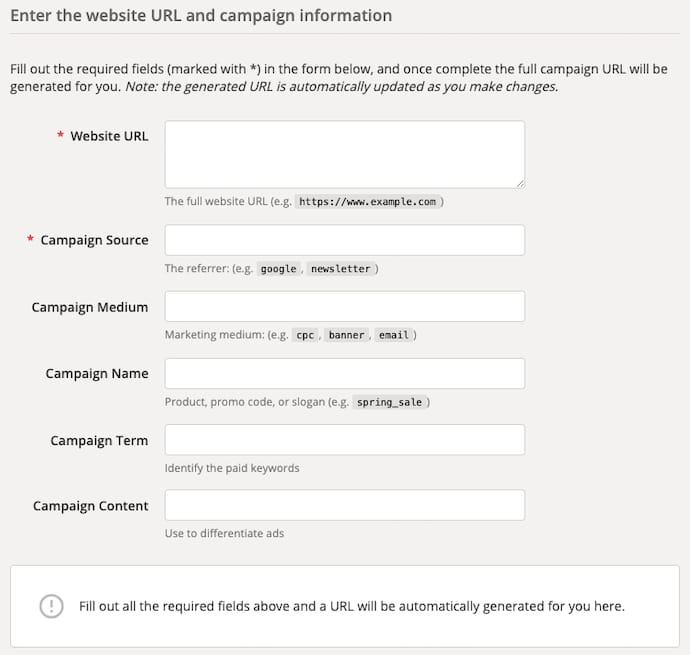UTM Parameters – Best Strategies
A study conducted by Forbes a few years ago revealed that only a mere 22% of marketers used data-driven purposeful efforts to achieve desired results for their companies.
Another interesting survey released by ITSMA and Vision Edge further showed that as much as 74% of marketers were largely unable to measure or point out the quantitative impact of their marketing efforts on business.
Considering the highly digital age that we are in – the age of big data and analytics, these numbers prove to be quite surprising. Even though marketers are equipped with all the latest technologies in digital marketing, they fail to make full use of the same.
We know for a fact that digital marketing efforts, including lead generation, email campaigns, and social media campaigns, generate tremendous results in terms of clicks, sign-ups, and whatnot.
But, how can marketing teams find out which strategies and channels are effective and which techniques are not? From the bigger picture, how can businesses function effectively if they have no idea where their efforts are taking them?
This is precisely where the power of tracking finds its relevance.
According to the numbers that we initially saw, a striking majority of marketers apparently fail to make use of this power. Here’s why it is a big mistake.
For starters, they give you the exact values of metrics related to different marketing venues that help you identify exactly what gets you positive results. For example, if there was a spike in traffic or a spike in the generation of good quality leads, you may assume different things. A change in campaigns? Just a good week? Something else?
However, what’s risky about making such assumptions is that if you don’t know the real cause, you cannot replicate it in the future.
For instance, considering the same example, you may assume the spike in traffic is a result of the campaign you ran on Twitter. However, on a detailed analysis, you may find that it is inviting the wrong kind of traffic – a set of people who are not a part of your target audience or your ICP and hence may not purchase from you.
Similarly, you may have redesigned your website around the same time, but by analyzing the details, you may find that the traffic spike was actually because of leads coming from one particular keyword on Google Ads.
Thus tracking the quantitative effectiveness of every marketing effort you make, such as website redesigning or campaigns, etc., gives you an exact range of data, using which you can make data-driven decisions to improve. Whether it’s your social media campaigns or your paid ads, or anything else that appears to be giving you better results, you can make a conscious choice to invest more in those very venues and reap benefits.
How can you effectively keep a check on which of these venues is working and which of these is not?
With UTM parameters.

What are UTM parameters?
UTM parameters are essentially short pre-defined text codes that you can simply add to the URL of your website or any other page that you wish to track essential data pertaining to traffic, visitor profiles, and sources. You can add these text codes to either your website URL or even your social media page URLs, landing page URLs, etc.
These text codes work in conjunction with analytics and marketing programs such as Google analytics or Salespanel to give you a detailed rundown of all that is happening with your website.
There are typically 5 different types of UTM parameters, each of which gives you detailed analytics related to a single venue. With these parameters in place, you should be able to figure out where your traffic is coming from, which type of content is driving it, and how they are getting to you.
Out of these 5 types that you can include in your URL, the first three are must-haves if you are looking for basic tracking information.
- Source – the source driving the traffic such as Instagram, Twitter, blog, ads, etc.
- Medium – the type of channel bringing in the traffic like social, organic, paid, etc.
- Campaign – the name of the campaign you are tracking.
- Content – the type of content bringing the traffic, such as an email ad or a video ad
- Term – the specific keywords that you used that brought in the traffic
Here’s what an example URL link would look like after incorporating all of these UTM parameters
http://www.yourdomain.com?utm_source=instagram&utm_medium=fb_ad&utm_campaign=winter_sale&utm_term=service_for_free&utm_content=video_ad
How can UTM parameters help?
UTM parameters can be used to track different aspects of posts and campaigns on different channels. As mentioned before, the five types of UTM parameters covering source, medium, content, campaign, and keywords can be used in different combinations to track the corresponding attributes according to priorities.
A good practice would be to use separate UTM links with separate parameters for each source and post to achieve more clarity and focused analytics related to important attributes. For example, you can customize the link to each post you publish on social media with different parameters. With the help of these tags, you can gauge where you got the most traffic from for each of your posts. You can also set up some posts with campaign tags and keyword tags if they are a part of specific digital campaigns that you initiated.
In the same way, you can use different UTM customized links for each newsletter you assign under each campaign. By using specific keywords and campaign names, you will be able to see which initiative of yours under which campaign got you the most clicks.
In addition to using different customized UTM links for each post, blog, newsletter etc. you can also have separate links for each parameter as well. You can track each campaign, ad copy, or social media post using the UTM links.
The way a UTM tracking program works is that you can track visitors or leads, or customers for each parameter. With this information, you can decide which campaigns, sources, and keywords to use extensively to grow moving forward.
Generating UTM parameter links with Google link builder
You can create UTM links to track attributes using different means, and one of those means is to use the Google link builder. It is one of the easiest methods to attach UTM parameters to your URLs.
What is Google link builder?
It is a dedicated tool offered by Google for marketers to add campaign parameters to URLs so that you can analyze them. It allows you to easily fill in your parameter requirements, and it will create a custom URL for you. It also provides the option for you to shorten the link so that it doesn’t look complicated or ugly. You can also copy and paste the link onto a separate link shortener.

Here’s how you can go about using the tool.
- First, head on over to the exclusive Google Analytics Campaign URL Builder. The page provides columns for you to fill in. Paste the URL of the page that you wish to create a customized URL for on the “Website URL” field.
- Enter the rest of the parameters that you wish to track under the respective fields.
- You can find the automatically generated URL at the bottom of the page
- Click on “Convert URL to Short Link” to create a shorter version of the link
- You can then use it in your social media posts or embed it in images etc., on your website.
This way, you can create UTM links for any post or page that you want, such as for your social media, newsletters, and Google ads.
Here’s an example of what you can do to create a UTM link for a social media post.
- Enter the link of the social media post or even your social media channel on the website link field (Eg. yourdomain.com/?)
- Under “source” add “Instagram”
- Under “medium” add “social”
- Under “campaign” add “social campaign”
- Under “content” add your social media profile link or particular post link
- Your URL will be generated at the bottom
It will look something like this:
https://www.yourdomain.com/?utm_source=instagram&utm_medium=social&utm_campaign=social_campaign&utm_content=postlink (or profilelink)
Similarly, to create a UTM link for a newsletter, you can use the following example values.
- Source – searchads
- Medium – google
- Campaign – competitorads
- Content – adlandingpage
The generated URL will look something like this:
https://www.yourdomain.com/technology_blog/?utm_source=searchads&utm_medium=google&utm_campaign=competitorads-1&utm_content=adlandingpage
For Google ads, you can enable UTM tracking with the help of a “final URL suffix.” The following example values can be used.
- Source – google
- Medium – cpc
- Campaign – <campaign id>
- Content – <ad group id>
- Term – keyword
The final URL will look something like this:
utm_source=google&utm_medium=cpc&utm_campaign={campaignid}&utm_content={adgroupid}&utm_term=keyword
If you want to use a template for Google Ads to track campaign id, ad group id, ad id, and keyword, you can simply insert this tracking template into your campaign settings:
{lpurl}?utm_campaign={campaignid}&adgroupid={adgroupid}&utm_content={creative}&utm_term={keyword}
Tracking UTM parameters on Salespanel
Tracking based on UTM parameters is fairly simple on Salespanel. Reports are pre-sorted based on those parameters, and they are also visible in visitor details. If you want to create segments or filter reports based on a particular parameter, you can also easily do that.
You can also combine UTM parameter filters with any other filter. For example, you can filter out leads who are from companies with over 200 employees and have searched for the keyword “lead scoring.”
To know more, please check out this article.
Conclusion
Adding UTM parameters and creating custom links for every marketing vertical you publish online, including your website and social media posts, will help you immensely in tracking traffic as well as visitors coming to your channels.
Use this information to not only scale your winning campaigns but also to show relevant content to your users based on results.
Sell more, understand your customers’ journey for free!
Sales and Marketing teams spend millions of dollars to bring visitors to your website. But do you track your customer’s journey? Do you know who buys and why?
Around 8% of your website traffic will sign up on your lead forms. What happens to the other 92% of your traffic? Can you identify your visiting accounts? Can you engage and retarget your qualified visitors even if they are not identified?


